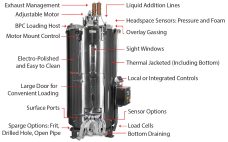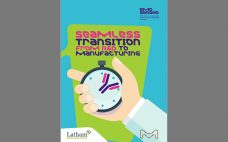A strong connection between turbidity and total suspended solids (TSS) has been linked in the past to measuring well defined particles in processes. Optical density probes have seen wide adoption in the biotechnology industry for monitoring cell growth within a bioreactor, whereas in-line turbidity sensors have been used to monitor filter performance. Turbidity measurements offer a rapid quantification of suspended solids but have not been used in the biotechnology industry for chromatographic resins. In this study, turbidity measured with equipment developed by PendoTECH was used with novel continuous chromatography technology developed by Chromatan…
Sponsored Content
Single-Use Bioreactors: Performance and Usability Considerations, Part 2
As the biopharmaceutical industry continues toward streamlined bioprocessing and intensified cell-culture biology, selection criteria of single-use bioreactors (S.U.B.s) and other bioprocessing technologies will become increasingly rigorous, emphasizing the importance of considering every aspect of technologies under evaluation. In part 1, we discussed performance for process control, including the maintenance of critical process parameters (CPPs), and highlighted bioreactor performance (e.g., mass transfer, power per volume, and temperature control) as a critical consideration during the selection of S.U.B.s (1). Part 2 focuses…
Seamless Transition from R&D to Manufacturing
Fast and cheap: These criteria are becoming ever more urgent drivers for manufacturers of biologics, faced with increased scrutiny on the costs of developing novel drugs, the lengthy timelines for delivering these drugs to patients, and the tightening competition to capitalize on new targets. The challenge for manufacturers is further heightened by the expectations to deliver on quality as well. Although development and production of molecules such as monoclonal antibodies (MAbs) have greatly benefited from the “platformization” of core technologies…
Key Considerations for Advanced Therapies Manufacturing
This webcast features: Thomas Page, PhD, Vice President, Engineering and Asset Development, Fujifilm Diosynth Biotechnologies This technical webinar covers key considerations to support manufacturing activities from the earliest stages of cell line, viral replication platforms and/or viral vectors identification stage leading into clinical production. Having a line of sight into commercial production and the requirements leading into commercial approval are also essential for success. Key messages: Flexibility in conjunction with high containment are key for success Application of closed systems…
Setting Up a Rapid Mycoplasma Assay to Support Recombinant Protein Production
Octapharma AB (OAB) in Stockholm, Sweden, is the site for Nuwiq human recombinant factor VIII (FVIII), production. The drug is produced in a human cell line cultured in a perfusion bioreactor using a closed system (to minimize contamination) and proprietary serum-free medium without animal-derived components. In accordance with regulatory guidelines, cell banks and cell cultures used for production of biological products must be free of mycoplasma. Traditional mycoplasma testing is a growth-based method that represents a significant bottleneck in quality…
Bioproduction Efficiencies Gained Using the New ExpiCHO Stable Production Medium
This webcast features: Shreya Lowmaster, Msc, Field Applications Scientis, Thermo Fisher Scientific Transition from the transient to stable production workflow exclusively in CHO cells with the new Gibco™ ExpiCHO™ Stable Production Medium and cGMP banked Gibco™ ExpiCHO-S™ cells. Transient titers in shake flasks and stable clone titers in a 50L Thermo Scientific™ HyPerforma™ single-use bioreactor were greater than 3.0 g/L in a fed-batch process with comparable product quality.
Accelerated Development, Manufacturing and Monitoring of Viral Vectors
The goals of process intensification are to enhance production while shortening timelines, lessening contamination and environmental risks to products and operators, and reducing operating footprints. Previous publications from Sartorius Stedim Biotech (SSB) have highlighted key elements of such activities. In this report, the authors extend the scope of this discussion to tools and technologies that enable intensification of viral vector manufacturing processes. The first article summarizes presentations from a 2018 seminar for viral vaccine manufacturers. Three guest presentations highlighted the…
Accelerating Biopharmaceutical Development with High-Throughput Glycan Screening and Multiple Attribute Methodology
Part 1 Development of biopharmaceuticals comprises many integrated steps, beginning with research and discovery and optimally ending with a commercial therapeutic molecule. Early screening of large numbers of clones and cell culture expression conditions is essential to identifying proteins that carry to greatest likelihood of clinical and commercial success. Part one of this report reviews how high-throughput glycan screening can significantly improve current analytical strategies relating to cell line development. Part 2 Minor impurities and changes in attributes such as…
Optimizing Unit Operations In Biopharmaceutical Manufacturing
There are many critical material-handling challenges regarding flow rates, pressure levels and the prevention of shear in the chromatography, virus filtration and TFF processes that are used in the manufacture of biopharmaceuticals. In order for these unique operations to be implemented successfully while handling fluids that can be sensitive, delicate and expensive, the operator must be aware of their specific operating characteristics and choose a pumping technology that can meet the strict demands for successful operation. While lobe and peristaltic…
Culture of 3D Cell Aggregates in Perfusion in a DASbox® Mini Bioreactor System
Three-dimensional (3D) culture systems provide cell–cell and cell–extracellular interactions that reproduce the cellular microenvironment in vivo better than typical two-dimensional monolayers. This property is of paramount importance in many applications, including disease modeling, drug toxicity assessment, and manufacturing of stem-cell–based products (1). Cultivation in stirred-tank bioreactors using perfusion mode opens up new possibilities in the cultivation of 3D cell aggregates. Perfusion allows for removal of detrimental metabolites, cell debris, and proteases from the culture as well as the addition of…










